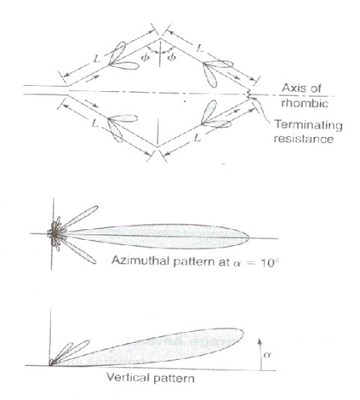Rhombic Antenna :
The rhombic antenna is as shown in fig . It consists of four wires in the form of a parallelogram in the horizontal plane above the earth the length of the wire is 2λ to 10λ.For transmission purpose the radio frequency energy is fed through a balanced line at one end and the resistor at the other end. In free space the maximum gain is along the main axis and the polarization horizontal.
The antenna could be used for both transmission and reception. Because of its simplicity it is a very popular antenna for HF transmission.
Each wire produces a main beam of radiation and a number of side lobes. The design of rhombic antenna consists of the determination of the three factors, the length L, the tilt angle $ and the height h.
The earth serves to deflect the main beam upward at some angle of elevation. Combining with the earth plane the antenna produces a vertical pattern with an angle of elevation α.
Advantages :
• It is a wideband antenna.
• It is a high gain antenna and the required angle of equation of main lobe be obtained.
• Design and structure are simple.
• Input impedance is constant for a range of frequency.
Disadvantages :
• As terminating resistance is used efficiency is less.
• The width of the main lobe changes with frequency.
---------------------------
Article by
St.Mary's Group
ECE Dept.

No comments:
Post a Comment